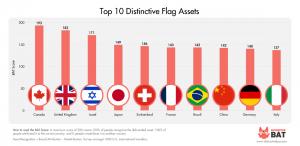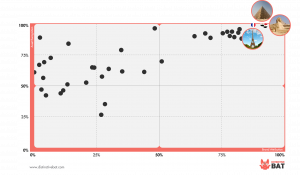Study Reveals Top Tourism Symbols Recognised by International Travellers
DUBLIN, IRELAND, April 10, 2024 /EINPresswire.com/ — In a comprehensive study conducted by Distinctive BAT, a leading Distinctive Brand Asset research agency, the most recognisable and distinctive symbols associated with nations were discerned from a sample of over 1,000 international travellers based in the U.S.A. The aim was to gauge their ability to recognise and correctly attribute a broad spectrum of icons and images related to countries and, in doing so, support tourism marketing.
Utilising the metrics of Asset Recognition and Brand Attribution minus Misattribution (referred to as the BAT score), the study has uncovered the most distinctive tourism assets:
1. Egypt’s Great Pyramid of Giza – 190
2. Egypt’s Great Sphinx of Giza – 188
3. The United Kingdom’s King Charles III – 187
4. The United Kingdom’s Royal Guard – 182
5. France’s Eiffel Tower – 179
6. Italy’s Pizza – 175
7. Mexico’s Mariachi Bands – 175
8. Australia’s Kangaroo – 173
9. Italy’s Leaning Tower of Pisa – 172
10. Spain’s Bullfighting – 169
The highest possible BAT score is 200, demonstrating 100% Asset Recognition, 100% Brand Attribution and 0% Misattribution.
Egypt boasts a number of Distinctive Brand Assets, most notably the ancient structures of the Great Pyramid and Great Sphinx of Giza. These iconic landmarks alone serve as powerful symbols of Egypt’s rich cultural significance. As such, the country can effectively leverage these symbols in tourism advertising campaigns, to ensure that consumers attribute the advertising to the correct country. This is especially important in light of so much passive advertising consumption across channels, whether that be in the social feed or during the commute to work.
These icons also help to keep their country top of mind anytime they appear in culture, effectively acting like free advertising media if they appear in a movie or a magazine. In addition, the more assets a country has, and more importantly the stronger they are in people’s memories, the more likely these countries are to come to mind when consumers think about holiday destinations.
Furthermore, the study highlighted the enduring appeal of people and animals in tourism branding. Characters consistently perform well, emphasising the human propensity to remember faces over places or things.
King Charles III, emblematic of the United Kingdom’s royal heritage, emerges as a strong performer, emphasising the crown’s significance to brand U.K., with the Royal Guard also scoring very high. While some might disagree with the concept of “the crown”, along with the cost, there is no doubting the role of “the crown” as a hugely effective marketing lever for the U.K.
Misattribution poses a challenge when imagery is more generic, as seen by confusion surrounding the Northern Lights. Most commonly, this scenery was attributed to Iceland, though there was also significant association with Norway, Finland, Canada, the USA, and even Antarctica, but not Sweden. Nordic countries will need to be careful in leaning too much on the Northern Lights in advertising; they could just be nudging along their neighbours as tourist destinations.
Flags serve as powerful symbols of national identity, with strong use of colour, shape, and iconography contributing to their distinctiveness. However, the research also reveals instances of misattribution, particularly concerning flags with similarities in colour scheme and structure. The Irish flag faced misattribution of 17% to Italy, due to its resemblance to the Italian flag. Similarly, the New Zealand flag experienced high misattribution (49%), due to its shared elements with the flags of the United Kingdom and Australia. While some countries and tourism advertising bodies think adding their flag will help “brand” their advert, it can go against them. The New Zealand tourism board would need to think twice if leaning too much into their flag in advertising as a branding device.
Considering flags a proxy for brand logos, it would be unlikely for a brand to run a campaign without this inclusion – though if the logo was stylistically similar to others, they would need to rely on other assets to fulfil their brand linkage. The same is true for countries and logos. Nations might consider putting national pride to one side when creating tourism advertising where more distinctive county assets can work better and with less competition.
Flags as Distinctive Assets:
1. Canada – 193
2. United Kingdom – 182
3. Israel – 171
4. Japan – 149
5. Switzerland – 146
6. France – 143
7. Brazil – 143
8. China – 142
9. Germany – 140
10. Italy – 137
As destinations vie for attention in an increasingly competitive landscape, several key considerations emerge:
• Embrace Cultural Heritage: Symbols deeply rooted in a nation’s cultural heritage, such as the United Kingdom’s King Charles III, resonate strongly with travellers.
• Diversify Representation: While certain assets, like the Great Pyramid of Giza, enjoy universal recognition, there is value in diversifying symbolic representation to capture the richness each destination’s cultural heritage.
• Limit Flag Reliance: Like brand logos, flags can suffer from misattribution if they are visually similar to others. Consider what imagery best represents the nation in question and make that the focal point, even if that isn’t the flag.
• Mitigate Misattribution: Vigilance is required to address misattribution challenges, particularly concerning ambiguous symbols like the Northern Lights and relatively generic landscape shots, especially in static advertising. Effective destination marketing strategies must strive for clarity to avoid inadvertently promoting neighbouring countries.
Cathal Gillen
Distinctive BAT
[email protected]
![]()
Originally published at https://www.einpresswire.com/article/702595634/beyond-borders-the-world-s-most-distinctive-tourism-assets






